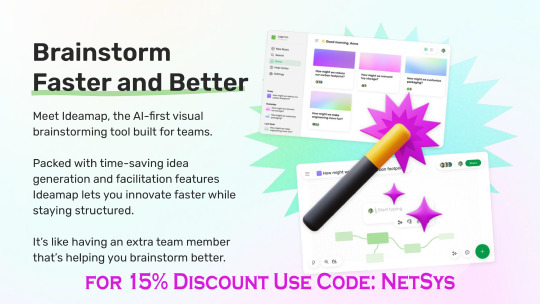#Interactive Elements
Explore tagged Tumblr posts
Text
#Instagram engagement tips#Instagram marketing#Instagram Reels trends 2024#Interactive elements#Short-form storytelling#social media strategies#User-generated content#viral Instagram Reels
0 notes
Text
youtube
Revolutionize Your Brainstorming with Idea Map AI!
In today's fast-paced world, creativity and innovation are essential for success. This video explores how Idea Map revolutionizes brainstorming sessions as an AI-powered tool that enhances productivity and creativity. With its intuitive design, users can easily create, edit, and organize ideas using drag-and-drop functionality.
For 15% Discount Use Code: NetSys
Idea Map's robust collaborative features empower teams to brainstorm together in real-time, regardless of location. By integrating with popular productivity software, it streamlines workflows while offering AI-generated suggestions that spark new connections. Join us as we dive into this game-changing tool!

#IdeaMap #BrainstormingTools
#Youtube#deaMap AI#Neturbiz#AI#Artificial Intelligence#Brainstorming tool#creativity boost#team productivity#user-friendly interface#drag and drop#interactive elements#collaborative capabilities#real-time brainstorming#integrated communication#personalized recommendations#innovative ideas#integration capabilities#project management#collaborative editing#innovative features#creative process#creative potential#generative#remarkable#idea#mind#mapping#team#collaboration
0 notes
Text
Why Microlearning Initiatives Fail: Understanding Limitations and Avoiding Pitfalls

Microlearning has gained significant traction in the training and development world due to its many benefits. Its bite-sized, focused approach to learning is ideal for today’s fast-paced environment, where attention spans are short, and time is limited. However, despite its advantages, microlearning initiatives often fail. The primary reasons for these failures are poor planning and implementation, as well as a misunderstanding of what microlearning can and cannot achieve. Another contributing factor is the unrealistic expectation that microlearning can solve all training problems. In this article, we will explore these issues in detail and provide guidance on how to avoid common pitfalls to ensure the success of your microlearning initiatives.
The Importance of Proper Planning and Implementation
Successful microlearning initiatives start with thorough planning and strategic implementation. Without a solid foundation, even the most promising microlearning projects can falter. Here are some key aspects to consider:
Clear Objectives and Goals: One of the first steps in planning a microlearning initiative is defining clear objectives and goals. What do you want to achieve with your training program? Are you looking to improve specific skills, increase knowledge retention, or drive behavior change? Having well-defined goals helps in designing focused and relevant microlearning content.
Audience Analysis: Understanding your audience is crucial. Conduct a thorough analysis of your learners’ needs, preferences, and learning styles. This information will guide the development of content that resonates with your audience and meets their needs effectively.
Content Relevance and Quality: The quality and relevance of your microlearning content play a significant role in its success. Ensure that the content is concise, engaging, and directly related to the learning objectives. Avoid overloading learners with unnecessary information.
Structured Delivery: Microlearning should not be a random collection of unrelated modules. It needs a structured delivery plan that ensures a logical flow of information. Each module should build on the previous one, creating a cohesive learning experience.
Assessment and Feedback: Incorporate assessment and feedback mechanisms to gauge the effectiveness of your microlearning modules. Regular assessments help in identifying areas where learners might be struggling and provide insights for further improvement.
Understanding What Microlearning Can and Cannot Do
Microlearning is a powerful tool, but it is not a one-size-fits-all solution. Understanding its strengths and limitations is essential for effective implementation.
What Microlearning Can Do:
Enhance Retention: Microlearning’s short, focused modules are designed to enhance knowledge retention. By breaking down complex information into smaller chunks, learners can absorb and retain information more effectively.
Provide Flexibility: Microlearning offers flexibility in terms of time and location. Learners can access content on-the-go, fitting training into their schedules without significant disruption.
Improve Engagement: Interactive elements and multimedia content in microlearning modules can significantly improve learner engagement. Gamification, quizzes, and scenarios make learning more enjoyable and motivating.
Address Specific Skills: Microlearning is ideal for targeting specific skills or knowledge areas. It allows for focused training on particular topics, making it easier to address specific learning needs.
What Microlearning Cannot Do:
Replace Comprehensive Training: Microlearning is not a substitute for comprehensive training programs. It works best as a supplement to more extensive training initiatives. Complex topics that require in-depth understanding may not be suitable for microlearning.
Solve All Training Problems: Microlearning is not a magic wand that can solve all training issues. It is most effective when used to address specific, well-defined learning objectives. Trying to use microlearning for every training need can lead to ineffective outcomes.
Develop Deep Expertise: While microlearning is excellent for imparting basic knowledge and skills, it is not designed for developing deep expertise. For advanced training and mastery of complex subjects, more comprehensive and immersive training methods are required.
Avoiding the Desperation to Overcome Pain Points with Microlearning
Another common reason microlearning initiatives fail is the desperation to use it as a quick fix for various training pain points. Here are some ways to avoid this pitfall:
Realistic Expectations: Set realistic expectations for what microlearning can achieve. Understand that it is a tool, not a cure-all. Align your expectations with the strengths of microlearning and recognize its limitations.
Integrate with Other Training Methods: Use microlearning as part of a blended learning approach. Combine it with other training methods such as instructor-led training, e-learning, and on-the-job training to create a comprehensive learning experience.
Continuous Evaluation: Continuously evaluate the effectiveness of your microlearning initiatives. Gather feedback from learners, monitor engagement and performance metrics, and make necessary adjustments to improve outcomes.
Focus on Quality Over Quantity: Don’t fall into the trap of creating numerous microlearning modules without considering their quality and relevance. Focus on developing high-quality content that delivers real value to learners.
Conclusion
Microlearning is a valuable tool in the modern training landscape, offering flexibility, enhanced retention, and improved engagement. However, its success depends on proper planning and implementation, a clear understanding of its capabilities and limitations, and realistic expectations. By avoiding the common pitfalls of poor planning and the desperation to use microlearning as a catch-all solution, organizations can leverage its strengths to create effective and impactful training programs. Remember, microlearning is most powerful when used thoughtfully and strategically as part of a broader training strategy.
#Microlearning#Training initiatives#Planning and implementation#Learning objectives#Audience analysis#Content relevance#Knowledge retention#Flexible learning#Engagement#Interactive elements
0 notes
Text
Latest Digital Designs (Etsy Shop) Kids Room 16x20 Posters



Etsy Shop
#DIY Crafts for Kids#Kid's Room Decor#Children's Bedroom Design#Nursery Decor#Playful Interiors#Whimsical Decor#Cartoon Characters#Animal Themes#Fantasy Landscapes#Colorful Patterns#Educational Decor#Interactive Elements#Creative Storage Solutions
0 notes
Link
Transform your home into a kid-friendly living space where creativity meets safety! 🌈🏠 Our latest guide dives into the art of designing a space that caters to the whims of kids while keeping things stylish for adults. Discover tips on safety, material selection, maximizing space, and how to infuse personal touches that make everyone happy. Ready to craft a haven your whole family will love? Dive into our guide now and make your home everyone’s favorite place to be! #KidFriendlyLivingSpace
0 notes
Text
0 notes
Text
How to Create and Sell Online Courses for Profit
How to Actualize and Advertise Online Courses for Profit Introduction:The agenda era has revolutionized the way bodies learn, aperture up opportunities for individuals to actualize and advertise online courses. If you accept ability in a accurate accountable or skill, creating and affairs online courses can be a advantageous venture. In this article, we will assay the accomplish complex in…

View On WordPress
#affiliate marketing#course improvement#course objectives#course performance#course structure#create#e-learning#e-learning platform#earnmoney#earnmoneyonline#earnmoneyonline2023#engaging content#expand offerings#expertise#industry trends#interactive elements#learnmoney#makemoney#makemoneyonline#makemoneyonline2023#makeoney#marketing strategy#monetize#moneyonline#moneyonline2023#ongoing support#online courses#pricing#professional development#profitability
0 notes
Text
How to Use Sqribble: The Ultimate Ebook Creator for Content Creators and Freelancers
Boost your content game with Sqribble! As the ultimate tool for ebook creation, Sqribble makes it easy to create engaging and professional-looking ebooks. Learn more in our latest article. #Sqribble #contentcreation #ebookcreator #professionallookingebook
Are you a content creator or freelancer looking for an easy way to create professional-looking ebooks? Look no further than Sqribble, the ultimate ebook creator software that takes the hassle out of design and formatting. In this article, we’ll show you how to use Sqribble to create engaging ebooks that captivate your audience. Getting Started with Sqribble To get started with Sqribble, simply…

View On WordPress
#content creation#digital publishing#ebook creator software#ebook design#engaging content#freelancers#interactive elements#professional-looking ebooks#self-publishing#Sqribble
0 notes
Text
Contemporary Scrapbook Trends
Scrapbooking has come a long way from its traditional roots, evolving into a dynamic and innovative craft that is constantly changing and evolving. Today’s scrapbookers have access to a wide range of materials, tools, and techniques, allowing them to create unique and personalized scrapbook layouts that reflect their individual style and aesthetic. In this blog post, we’ll explore some of the top…
View On WordPress
#contemporary#designs#Digital#hand lettering#interactive elements#journals#MASCrapping#masculine scrapbooking#minimalism#mixed media#modern#ScrapBook#scrapbooking#scrapbooks for men#trends
1 note
·
View note
Text



The Fifth Element (1997)
#the fifth element#90s#cult classic#retro futuristic#cyberpunk aesthetic#retrofuture#retro futurism#new york city#aesthetic#90s movies#90s aesthetic#cyberpunk#graphical user interface#user interaction#user interface#graphic design#motion graphics#ui#ui ux design#uidesign
484 notes
·
View notes
Text

This was going to be a panel of a little comic but I got too invested in drawing minute background details so, here.
#They are having an argument over 1) whether crops can be grown on the moons 2) what - if any - impact does this have on the feasibility#of an afterlife being located on the moons#Brakul is a partial convert to the Imperial Wardi faith but this mostly entails having adopted the seven faced God (and some#other elements of the belief system) into his worldview and participating in expected rites while retaining his central#ancestor veneration practices completely unchanged and mostly prioritized.#This doesn't actually cause much friction in of itself with the big exception being disagreements on the afterlife#Wardi practices surrounding death prioritize proper handling of the corpse and funerary rites in order to get the dead where they#need to be- death is a fraught transition from one state to another. analogous to birth. The role of the living is to get the dead through#this transition (preventing them from being stuck earthbound as earthbound ghosts - which is the Bad afterlife). Once the dead#make it to the moons that's it. They don't really interact with the living. There's plenty of conceptualization of what it's Like#in the lunar lands but the cultural priority is not even slightly on the Logistics of existence there.#Whereas the CORE of religious practice among the Hill Tribes is ancestor veneration - ancestors remain interactive with the living#and require/desire their continual support. They are conceptualized as having earthlike 'lives' where they eat and drink#and grow crops and herd livestock and they need the support of the living (in prayers and offerings) to do so prosperously.#There is a HIGH cultural priority on the logistics of their afterlife and it's self-apparent that the world of the dead needs fertile earth#to support them.#So like bottom line Brakul thinks there's no goddamn way that the moons could support an afterlife (they are described as#barren rock that was flung into the sky during creation and certainly Look that way)#and that the Wardi are just wrong about their afterlife's location. They probably go to the celestial fields (which are located#behind the moons and stars) like everyone else#And Janeys finds this aggravating and doesn't see his fucking point but has developed a nagging concern that Brakul Could be#partly right in that the celestial fields could Maybe exist in addition to the lunar lands.#So like maybe they aren't going to go to the same place when they die?#He's already terrified that he'll be stuck as an earthbound ghost and really doesn't want to be even further separated so#he figures he should make sure he gets himself dead and cremated at the same time as Brakul so they can navigate the#transitional period together.#Brakul is unconcerned because he figures that if Janeys actually does get stuck on those barren ass moons he can just kinda#Go Get Him#Ancestor spirits fly to the earth all the time and the moons would be a much shorter distance. Probably wouldn't be an issue.#Long story short these disagreements and underlying anxieties result in fights over whether you can grow corn on the moons or nah
143 notes
·
View notes
Note
Hi!! Can I have a little witch and bunny mood board?? No pacifier, pastel colours. Thank you! 🐇
Yes!!










#Witch#and#bunny#!!!!#with pastel colors of course#i wasn't sure if you meant real witch or fictional witch so i went with elements of both!#anyway this was a lot of fun#so i hope you like it!#sfw interaction only#agere#sfw agere#moodboard#age regression#agere moodboard#sfw littlespace#age dreaming#no pacifier#witchcraft#....?#bunnies#pastel colors#bright colors
177 notes
·
View notes
Text
The greek myth inaccuracies in kaos are actually brilliant if you know how to have fun and can appreciate the impeccable rapunzelxmavis im lesbo meme vibes they have going on. It is about time someone brought the spirit of those 2010s videos where people would edit disney princesses from different films interacting and being friends to a greek mythology adaptation and I for one am glad it resulted in me watching old men have sex
#kaos#like why would prometheus and charon be interacting why would polyphemus be running a bar with the fates#idk but im loving it#Ive been known to beat adaptations to death over innacuracies but when theyre fun inaccuracies i dont care#like if its a direct retelling of greek myths and u randomly change a bunch of details and characters it woukld be like why#but if its a whole new thing with mythological elements its funnnnnnnnnnnnnnnnnnnnnnnn#like omg underworld medusa pop off
169 notes
·
View notes
Text
Getting a Microlearning Lesson Right: A Blueprint with the Microlearning Map

In the fast-paced world of digital learning, microlearning has emerged as a powerful tool for delivering education in bite-sized, easily digestible chunks. This approach is particularly effective for busy professionals who need to acquire new skills quickly and efficiently. However, creating an effective microlearning lesson can be challenging without a clear plan. That’s where a microlearning map comes in. A well-structured microlearning map serves as a blueprint, guiding educators through the process of designing and implementing successful microlearning lessons. In this article, we will explore the concept of a microlearning map and provide a step-by-step format to help you get it right.
Understanding Microlearning
Before diving into the specifics of a microlearning map, it’s important to understand what microlearning is and why it’s effective. Microlearning refers to the delivery of educational content in small, focused segments. These segments typically last between 3 to 10 minutes and are designed to achieve a specific learning outcome. The benefits of microlearning include increased learner engagement, better retention of information, and the flexibility to learn at one’s own pace.
The Need for a Microlearning Map
Creating a microlearning lesson involves more than just breaking down content into smaller parts. It requires careful planning to ensure that each segment is meaningful and contributes to the overall learning objective. A microlearning map serves as a visual representation of this plan, outlining the structure, content, and flow of the lesson. It helps educators organize their ideas, identify key learning points, and ensure a logical progression from one segment to the next.
Steps to Create a Microlearning Map
Define the Learning ObjectivesThe first step in creating a microlearning map is to clearly define the learning objectives. What do you want learners to achieve by the end of the lesson? These objectives should be specific, measurable, achievable, relevant, and time-bound (SMART). For example, if you’re creating a microlearning lesson on customer service, a learning objective might be, “By the end of this lesson, learners will be able to handle customer complaints effectively using a three-step process.”
Identify Key Content SegmentsOnce the learning objectives are defined, the next step is to identify the key content segments that will help learners achieve these objectives. Each segment should focus on a single concept or skill and be designed to fit within the 3 to 10-minute timeframe. For the customer service example, key content segments might include understanding customer complaints, the three-step process for handling complaints, and practicing the process through scenarios.
Determine the Delivery MethodMicrolearning can be delivered in various formats, including videos, interactive modules, infographics, quizzes, and more. Choose the delivery method that best suits the content and learning objectives. For instance, videos might be effective for demonstrating the three-step process, while interactive modules could provide hands-on practice.
Create a FlowchartA microlearning map often takes the form of a flowchart, visually representing the sequence of content segments. Start by placing the learning objectives at the top, followed by the key content segments in the order they will be presented. Use arrows to indicate the flow from one segment to the next. This flowchart helps ensure that the lesson progresses logically and that each segment builds on the previous one.
Develop the ContentWith the flowchart in place, it’s time to develop the content for each segment. Keep the content concise and focused, ensuring that it directly supports the learning objectives. Incorporate multimedia elements, such as images, videos, and audio, to enhance engagement and retention. For the customer service lesson, the segment on understanding customer complaints might include a short video explaining common types of complaints and their causes.
Add Interactive ElementsInteractive elements are crucial for engaging learners and reinforcing key concepts. These can include quizzes, polls, drag-and-drop activities, and scenario-based exercises. Incorporate these elements throughout the microlearning lesson to keep learners actively involved. For example, after presenting the three-step process for handling complaints, include a scenario-based exercise where learners can practice applying the process.
Review and ReviseOnce the content is developed, review the entire microlearning map to ensure that it aligns with the learning objectives and follows a logical progression. Gather feedback from colleagues or test the lesson with a small group of learners to identify any areas for improvement. Make necessary revisions to enhance clarity, engagement, and effectiveness.
Implement and EvaluateAfter finalizing the microlearning lesson, it’s time to implement it. Deliver the lesson to your target audience and monitor their progress. Use analytics tools to track engagement, completion rates, and assessment scores. Collect feedback from learners to evaluate the effectiveness of the lesson and identify any areas for further improvement.
Sample Microlearning Map Format
To provide a practical example, let’s create a microlearning map for a lesson on “Effective Email Communication.”
Learning Objectives:
Understand the key components of a professional email.
Write clear and concise email messages.
Use proper email etiquette.
Content Segments:
Introduction to Email Communication (Video, 3 minutes)
Components of a Professional Email (Infographic, 5 minutes)
Writing Clear and Concise Emails (Interactive Module, 7 minutes)
Email Etiquette (Quiz, 5 minutes)
Scenario-Based Practice (Scenario Exercise, 10 minutes)
Flowchart:
Introduction to Email Communication ➔ Components of a Professional Email ➔ Writing Clear and Concise Emails ➔ Email Etiquette ➔ Scenario-Based Practice
Interactive Elements:
Quiz on Email Etiquette
Scenario-Based Exercise: Responding to Different Email Situations
Conclusion
Creating a microlearning lesson requires careful planning and organization to ensure that each segment is effective and contributes to the overall learning objective. A microlearning map serves as a valuable tool in this process, providing a clear blueprint for designing and implementing successful microlearning lessons. By following the steps outlined in this article and using a structured format, educators can create engaging and impactful microlearning experiences that meet the needs of today’s learners. Whether you’re teaching customer service skills or effective email communication, a microlearning map can help you get it right every time.
#Microlearning#Microlearning lesson#Microlearning map#Educational content#Learning objectives#Bite-sized learning#Digital learning#Interactive learning#Content segments#Learning outcomes#Flowchart#Delivery method#Multimedia elements#Engagement#Retention#Scenario-based learning#Interactive elements#Effective email communication#Professional email#Email etiquette#Learning progression#Learning blueprint#Educational strategy#Lesson planning#Instructional design#Learning experience#Learning effectiveness#Training content#Educational framework#Training methodology
0 notes
Text
Still weird seeing Twilight be so honest with Yor about struggling to turn his brain off and just *be*. A good kind of weird, of course. I could never imagine volume one Twilight being so open with her (or anyone, really). This chapter was so nice with its references to all the way back then and showing how far they've come since. Still some sneaky Project Apple seeds being laid, of course, but overall, this was a pleasant checkpoint. A little calm before the next storm, which was sorely needed after the last arc
#I did think he would backpedal more after mole hunt arc and tbh he likely still will but for now he's actually showing growth#Anya too in her adapting how best to manipulate him. Yor's chara development wasn't on full show this file#but that doesn't mean she hasn't grown too (her interactions with the work trio and Melinda especially show so).#Yor now drawing others out of their shells rather than staying quiet. appreciating what she has rather than letting it pass her by.#And seeing Martha again after last arc was just laced with irony. She and Becky acted the same as ever but now we have more context.#I'm glad this series is good about breathers in its pacing despite what elements of the fanbase may proclaim#spy x family#sxf manga spoilers
130 notes
·
View notes
Text
made a lil shadow forest on my bed 🛏️
#art#3d art#ar#augmented reality#digital art#artists on tumblr#video#process video#art process#figmin xr#vr#virtual reality#light is still so incredibly fun to play with#the light is a little floating eyeball#i wanna add some type of game element to the forest but idk what yet#i scaled the whole thing up to life size but the shadows don’t cast as far#so i gotta think of a tabletop-sized interaction i can add 🤔
203 notes
·
View notes